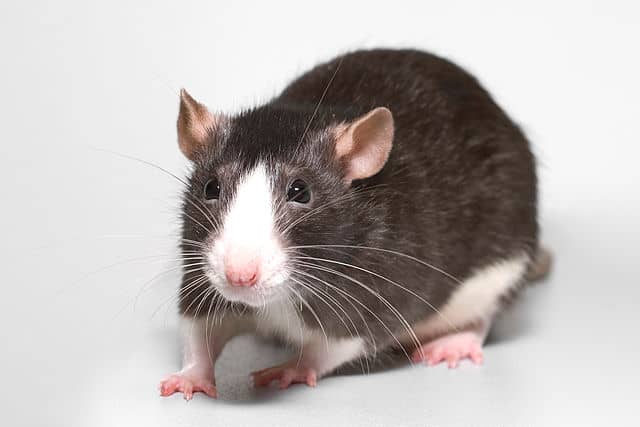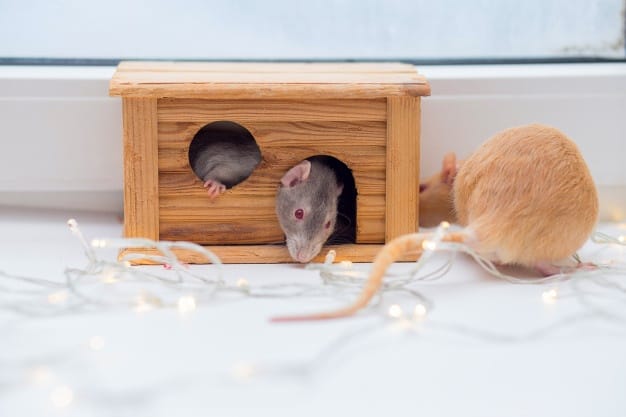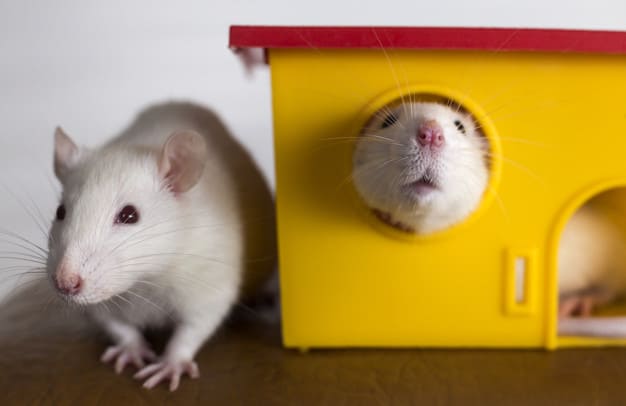So, you want to get a pet rat? I think you’re making a great decision. Rats are awesome pets. They’re smart, can learn tricks, are affectionate, cheap, and relatively low maintenance. However, before you dive in and get a rat as your next pet there are some things you need to know. It’s never a good idea to go into pet ownership blindly, even when it comes to small pets like rats.
There are many things that you need to be prepared for and for that reason it’s important you do your research before you buy a rat.
In this guide, I’m going to go over everything you need to know before you get your first pet rats. I will cover their housing, the difference between domesticated and wild rats, their temperament, how many rats you should get, and much more.

Pet Rat Care Sheet
| Name of species | Rattus Norvegicus |
| Size | 11 to 12 inches |
| Temperament | Social, affectionate, intelligent |
| Diet | Omnivorous |
| Lifespan | 2 to 3 years |
| Experience required | Great for beginners |
| Minimum cage size | 24” L x 24″ W x 24” H (2 cubic feet per rat) |
Pet Rat Overview

Pet rats, also known as fancy rats, are not the same as wild rats. Almost all domesticated rats are descendants of the Rattus Norvegicus also known as the Norwegian Rat. These rats were domesticated as pets at the beginning of the 20th century. There are several differences between domesticated rats and wild rats.
First off, domesticated or pet rats are much more sociable towards humans than wild rats. Wild rats do not like humans and are afraid of them. They run away if they spot a human and only enter their presence if they know food is nearby. Domesticated rats on the other hand are much more social. They enjoy spending time with humans and other pet rats. They can form bonds with humans and are generally quite affectionate towards them.
Secondly, there’s a difference in size. Pet rats are quite a bit larger than wild rats. In the wild many rats die before they can reach their maximum growth potential and reach a maximum size of 9 to 10 inches. In captivity, however, they have longer lifespans. This, combined with the fact that they usually have a better diet in captivity makes them grow larger. In captivity rats usually grow to between 11 and 12 inches. Domesticated rats are also heavier because they have access to more food and move around less.
Are rats good pets?
In general, rats are great pets for almost anyone, from beginners to experienced pet owners. However, whether rats will be a good pet for you depends highly on what you’re looking for in a pet. If you’re looking for a pet that doesn’t have a very long lifespan, is relatively easy to care for, is intelligent, likes to play, is affectionate, and can learn tricks, then rats are a great pet for you. On top of that, rats are great pets for children. Compared to other rodents, like hamsters, they rarely bite. Furthermore, it can be very fun for children to teach tricks to a pet rat.
On the other hand, if you’re looking for a pet to spend many, many years with, then a fancy rat might not be for you due to its short lifespan. In that case, other animals might be a better fit.
For most people, the pros heavily outweigh the cons of having a pet rat.
Pet rat breeds
It’s commonly believed that there are many different breeds of pet rats. It’s easy to see why people think so. Rats come in many varieties, from dumbo to hairless, to tailless, to white rats. However, this is a misconception. All pet rats are part of the same breed known as “fancy rats”, which are descendants of the Norwegian Rat. All the different rat types are simply varieties of that breed, but not distinct breeds themselves.
The different varieties are these:
- Standard
- Hairless (as the name suggests, this variety has no hair)
- Tailless (as the name suggests, this variety has no tail)
- Dumbo (larger and rounder ears)
- Rex (great for people who are allergic to other types of rats)
- Satin (shiny, silky coat)
- Marked (two different color patterns)
- AOV (Any Other Varieties)
Temperament and behavior

In nature, rats are very social animals that live together in groups called a “mischief”. In captivity, they exhibit the same social behavior, but towards humans and the other rats that they live with. Since rats are such social animals they make very good family pets. They’re able to bond with the whole family rather than only their primary caretaker. Many rats love to spend an evening on the couch with their human family.
They are also very affectionate animals that like to be petted. A good spot to pet your rat is behind their ears and their cheeks. When you pet your rat, they may start grinding their teeth. This is nothing to worry about and can be a sign that they enjoy it, similarly to a cat’s purring. Rats also love to cuddle and are very social with their human owner.
Another thing you might notice is that your rat’s eyes will bulge out of their sockets. This is quite a weird and scary sight when you first see it, and you might think that something is wrong. Luckily, you don’t need to worry about it. There’s nothing wrong with your rat, he’s just enjoying himself and relaxed! You should only worry about their eye-bulging if it’s persistent and doesn’t go away.
They are also not aggressive pets, especially if they’ve been raised properly. In general, pet rats do not bite humans, although it is a possibility that they do so if they’re scared. What’s more common is that they nibble slightly when they’re grooming you but this does not hurt and is actually quite cute. Rats do this to show affection, so it’s actually a good thing if they do this!
Rats are also very playful and are very easily tamed. The fact that they’re so intelligent and love to learn allows you to teach them all kinds of amazing tricks. You can teach them to come to you when called, train them to stand on two legs, play fetch, have them jump through hoops and they can even learn to complete mazes you create for them.
Overall, their temperament and behavior are pretty much ideal for a small pet.
Price
The cost of owning any pet is always an important consideration. After all, it’s good to know how much you’ll need to budget before you take on the responsibility of caring for a pet. Luckily, rats are quite cheap pets. Especially if you compare them to other pets like dogs or cats the costs of buying and maintaining a rat are quite low.
I have done a complete cost breakdown of owning a rat here which goes into more detail but I’ll give you the raw numbers here as well.
When you get 2 pet rats you should expect to spend around $215 upfront. This includes the cost of buying the rat itself, the cost of their cage, and every other one-time cost.
You should also expect to spend around $57.50 per month on your two rats. This monthly cost includes their food, bedding, budgeting for vet costs, and other recurring costs.
As you can see the costs aren’t very high compared to some other animals. Nevertheless, they do still require you to have some money so you can give them a good life.
Caring for a pet rat
Housing

Housing a pet rat is not that hard. You need a cage, some toys, bedding, and other accessories like a water bottle and a food dish and you’re pretty much good to go.
However, while housing a rat is relatively simple there are some things you need to take into account. For instance, the size of their cage. The minimum recommended cage size you’ll see recommended online very often is 2 cubic feet of space per rat.
However, 2 cubic feet of space is quite hard to visualize, after all, who really knows what a cubic foot of space looks like? I certainly don’t. To make it easier to visualize, a cage of the following size: 25 inches in length x 12 inches in width x 14 inches in height is about 2.4 cubic feet in size – the minimum for a single rat. Keep in mind though that this is the minimum recommended size for a single rat. In general, the larger the better. Also, if you get more than 1 rat (which you should) you will of course need a larger cage as well.
Another important thing to know is the bar spacing. The optimal bar spacing for your rat cage should be around 0.5 inches. This is small enough to keep young and tiny rats inside while being big enough for your rats to climb on it. Vertical or horizontal bar spacing is a matter of taste – rats can climb either.
Toys
Rats do not do well in an empty cage. These intelligent animals need toys to play with for mental stimulation and to prevent boredom.
In addition, they need chewing toys. The reason why they need chewing toys is that these rodents have teeth that never stop growing. Chewing toys allow them to wear down their teeth. If they do not wear down their teeth they will become too long and become a problem.
They also need an exercise wheel. Rats have lots of energy and a wheel is the best way for them to release some of this energy.
Other good toys to include in their cage are tunnels, climbing toys, and hiding houses.
Time commitment
Another important consideration is the time commitment. Rats are quite low maintenance compared to some other pets. However, no pet can truly be considered low maintenance and that includes rats.
Rats are sometimes called “low maintenance dogs” because they have similar intelligence and loyalty. Rats are indeed a lot lower maintenance than dogs, after all, you don’t need to take them on daily walks or anything like that. However, you will still spend a good amount of time caring for your rat.
You need to play with them, take them to the vet when they need it, feed them, clean their cage, and many other things.
You should expect to spend to take your rat out of their cage for about an hour every day to play with them. Rats are highly intelligent creatures, if you keep them in their cage too much they can become bored very easily. This time spent with them out of their cage also allows you to bond with your rats and form a friendship with them.
If you have a day where you’re sick or simply do not have the time to play with them it’s not a huge problem as long as they have a companion living with them in their cage and as long as it’s not too frequent of an occurrence.
In total, the time commitment of caring for pet rats will be around 1.5 hours a week to clean their cage, feed them, and check their health + however long you decide to play with them every day.
However, I expect that you get a pet rat because you want to spend some time with them. After all, there’s not much of a point in getting a pet if you’re not going to spend time playing and bonding with it.
Feeding
Just like humans, rats are omnivores. This means that they can feed on both meat and plants. In the wild, rats eat pretty much anything they can get their tiny little paws on, no matter if it’s good for their health.
However, in captivity, we can be a little bit more careful about what they eat since we have more control over their diet. A domesticated rat should have a diet that consists of 80% pellets and 20% fruits and vegetables. The pellets you can buy at a pet store and the fruits and vegetables you feed them can be many of the same fruits and vegetables that you eat. You can also occasionally feed them meat.
On the whole, feeding a rat is not hard. If you’d like to get an idea of good fruits and veggies that rats can eat, here is a list of examples:
- Broccoli
- Potatoes
- Asparagus
- Kale
- Peas
- Pak Choi
- Cauliflower
- Corn
- Carrots (in small amounts)
- Strawberries
- Blueberries
- Melon
- Grapes
- Kiwis
When feeding them vegetables or fruits it’s recommended to have either organic produce or to wash it properly before feeding. If you do not wash it properly the pesticides on the skin of these foods can pose a threat.
As far as treats go you can give them seeds, unsalted nuts, popcorn, eggs, rice, or cheese. Alternatively, you can buy specialized rat treats online. If you’re curious about which the best ones are, I’ve created an overview of the best rat treats here.
Health & Lifespan
Rats are quite hardy, but they are susceptible to quite a few diseases. Many rat owners report having to take their pets to the vet quite often.
Respiratory issues are especially common among rats because they are born with Mycoplasma Pulmonis which is a respiratory disease.
Your rat may or may not show symptoms depending on its immune system, living conditions, and stress. Symptoms to keep an eye out for on your rat are sneezing, wheezing, difficulty breathing, and lethargy.
If you notice any of these symptoms you should take your rat to the vet who will most likely prescribe an antibiotic.
Other common issues in rats are ear infections, bumblefoot, scabbing, and unfortunately, cancer.
Rats have quite a short lifespan. The average pet rat lives between 2 to 3 years.
This can be a benefit or not, depending on the person. If you’re in the market for a pet that’s not a long-term commitment then the short lifespan of the rat is ideal. However, it also means that you have to be mentally prepared for the fact that your rat will most likely die 2-3 years after you get it, no matter how well you care for it.
Within those 2 to 3 years you will have most likely formed a strong bond with your rats and it will, of course, be sad to see them go.
Grooming
Unfortunately, rats are often stereotyped as dirty creatures. This is a mischaracterization. They’re not dirty animals at all and they spend a lot of time grooming themselves. A healthy rat that’s kept in a cage that’s cleaned frequently does not smell bad.
If you notice bad smells coming from your rat it might indicate that there’s something wrong with him and you might want to take him to the vet to get checked out.
Also, if there are bad smells coming from their cage this is most likely caused by their urine and them marking their territory. Their urine contains ammonia which can smell quite bad. Make sure to clean their cage frequently and change their bedding often. If you do, you shouldn’t have any issues with smells. Most rat owners clean the cage at least once a week.
A healthy rat does not need to be bathed and will not smell.
Where to buy a pet rat
When it comes to buying a rat you have two options: a breeder or a pet shop.
Most pet shops have rats for sale and usually sell them for a cheap price and it’s definitely possible to get a perfect rat from a pet store. However, buying one from a pet store is generally not recommended for several reasons.
First off, since pet stores do not always separate by gender it’s possible that you accidentally take home a pregnant female and up with unwanted baby rats. This is not a huge risk, but it is something that has happened.
Secondly, you don’t know how these rats have been treated and handled. If the pet shop you buy from has not treated the rats well they might not make for very good pets.
Also, you don’t know how early they were weened or if they’re more prone to certain genetic disorders.
When you buy from a breeder, also known as a rattery, you usually pay a premium. In exchange, you get a rat that has usually been treated better and that you know more about. They have also received more individual care and are therefore usually tamer.
On top of that, ratteries usually select only the rats with the best genetics to breed. This gives them better colorations, makes them less prone to health issues, and usually means they’re friendlier.
Ultimately the choice is yours, but I recommend breeders over pet shops.
Choosing your rat
Once you’ve decided if you want to buy one from a pet store or a breeder you usually get your pick of the litter. But how do you make your choice? You should take a close look at the rat before you take him home to ensure you get the best pet rat. Keep an eye out for these signs:
- No discharge in eyes, ears, or nose.
- Clean coat (healthy rats groom themselves a lot)
- A firm and well-rounded body
- An active and curious disposition – the rat should not be scared or panic when being handled. Also, make sure it’s not too inactive because this might indicate they’re ill.
- Check if they have a limp when walking
- Make sure they have a pink tail and ears
You should also decide which color rat you prefer. Rats come in many different color variations, ranging from white to black.
How many pet rats should you get?
Many people wonder if it’s better to have a single rat or to get more than one. I would definitely not recommend getting a single rat. Rats are very social animals and they also have a lot of energy. I highly recommend you buy at least 2.
As their owner, you will, of course, want to spend a lot of time with them. However, I assume that you will not be able to be around them all the time. Even if you play with your rat for 2 hours a day they will most likely still want to play more.
You have to keep in mind that for your rat their entire life happens in your home, and the majority of it happens in their cage, they can not leave to find something to do. For that reason, they should have a friend living with them in their cage. They can play with their rat friend when you’re done playing and you will have nothing to feel guilty about.
Having more than one rat also means that you can skip a day of playing when you’re too busy and they will have their rat friend to pick up the slack. It makes the experience of taking care of a rat much easier and gives you more leeway.
It’s also just a lot of fun to watch your rats interact with each other. They will play together, groom each other and generally mess around a lot. Also, getting two rats isn’t that much more expensive than buying a single rat so there’s not really any reason not to get two of them.
In general, it’s better to get same-sex pairs of rats. Unlike some other animals, male rats get along quite well with one another, especially if they’ve been introduced at a young age or if they were from the same litter.
Different sex rats can also work, but you do have to make sure that you neuter or spay them. If you do not, you will have dozens of rat babies before you know it.
Final words
Overall rats are great pets that are not too hard to care for. Their diet is quite simple compared to some other pets. Also, while no pet can truly be called low maintenance, rats do not require as much of a time commitment as some other animals that people keep as pets. They’re also relatively inexpensive making them a great pet for beginners and experienced pet owners alike.
It’s a shame that so many people overlook the potential that rats have as pets because they perceive them to be “dirty” or are scared of them. Rats are not scary or dirty at all, in fact, it’s quite the opposite. They groom themselves more often than most animals and are quite clean creatures by nature.
Rats are affectionate, smart, and inquisitive rodents that will make a great addition to your family if you give them a chance to prove themselves!
- How Long Do American Eskimo Dogs Live? Important Factors and Care Tips - September 29, 2023
- Do American Bulldogs Need Grooming? Essential Tips and Care Guidelines - September 29, 2023
- Do Bengal Cats Enjoy Playing? Essential Tips for Keeping Them Active - September 29, 2023